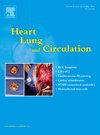Transcatheter Aortic Valve Implantation in Patients at Intermediate and Low Risk Is Not (Yet) the Existential Threat That Surgeons Feared: A Retrospective Analysis of Medicare Claims Data
IF 2.2
4区 医学
Q2 CARDIAC & CARDIOVASCULAR SYSTEMS
引用次数: 0
Abstract
Background
In Australia, the role of surgical aortic valve replacement (SAVR) and transcatheter aortic valve implantation (TAVI) in patients who are suitable for both procedures remains controversial. In 2022, new Items were added to the Medicare Benefits Schedule (MBS) to allow patients at intermediate and low risk with appropriate private health insurance to undergo TAVI. The Cardiac Society of Australia and New Zealand supported these changes whereas the Australian and New Zealand Society of Cardiac and Thoracic Surgeons opposed them. The aim of this study was to document subsequent private TAVI activity in patients at intermediate and low risk, relative to both private TAVI activity in patients at high risk and private SAVR activity.
Method
A retrospective population-level descriptive study was undertaken, using Medicare claims data obtained from Services Australia.
Results
Among private patients who underwent TAVI, the groups at high, intermediate, and low risk all had a median age between 75 and 84 years. Only 1% were aged ≤64 years (86/6,586), and 80% of these were at high risk (69/86). Among private patients at intermediate and low risk who underwent TAVI and private patients who underwent SAVR, only 4% of patients aged 55–64 years chose private TAVI over private SAVR (8/211), and 63% of these were at intermediate risk (5/8).
Conclusions
The introduction of MBS Items for private TAVI in patients at intermediate and low risk without accompanying age exclusion criteria has not (yet) had a major impact on private SAVR activity. This suggests that the multidisciplinary heart team (TAVI case conference) approval process remains an effective mechanism for ensuring access to private TAVI is consistent with international guidelines.
经导管主动脉瓣置入术在中低风险患者中并不是外科医生所担心的生存威胁:对医疗保险索赔数据的回顾性分析。
背景:在澳大利亚,手术主动脉瓣置换术(SAVR)和经导管主动脉瓣植入术(TAVI)在适合这两种手术的患者中的作用仍然存在争议。2022年,医疗保险福利计划(MBS)增加了新的项目,允许拥有适当私人医疗保险的中低风险患者接受TAVI。澳大利亚和新西兰心脏协会支持这些改变,而澳大利亚和新西兰心脏和胸外科医生协会则反对。本研究的目的是记录中低风险患者随后的私人TAVI活性,相对于高风险患者的私人TAVI活性和私人SAVR活性。方法:采用从澳大利亚服务局获得的医疗保险索赔数据,进行回顾性人群水平描述性研究。结果:在接受TAVI的私人患者中,高、中、低风险组的中位年龄均在75 ~ 84岁之间。年龄≤64岁者仅占1%(86/ 6586),其中80%为高危人群(69/86)。在接受TAVI的中低风险私立患者和接受SAVR的私立患者中,55-64岁的患者中只有4%的人选择私立TAVI而不是私立SAVR(8/211),其中63%的患者处于中等风险(5/8)。结论:在没有附带年龄排除标准的中低风险患者中引入MBS项目对私人TAVI活动没有(尚未)产生重大影响。这表明多学科心脏小组(TAVI病例会议)批准程序仍然是确保获得私人TAVI符合国际准则的有效机制。
本文章由计算机程序翻译,如有差异,请以英文原文为准。
求助全文
约1分钟内获得全文
求助全文
来源期刊

Heart, Lung and Circulation
CARDIAC & CARDIOVASCULAR SYSTEMS-
CiteScore
4.50
自引率
3.80%
发文量
912
审稿时长
11.9 weeks
期刊介绍:
Heart, Lung and Circulation publishes articles integrating clinical and research activities in the fields of basic cardiovascular science, clinical cardiology and cardiac surgery, with a focus on emerging issues in cardiovascular disease. The journal promotes multidisciplinary dialogue between cardiologists, cardiothoracic surgeons, cardio-pulmonary physicians and cardiovascular scientists.
 求助内容:
求助内容: 应助结果提醒方式:
应助结果提醒方式:


